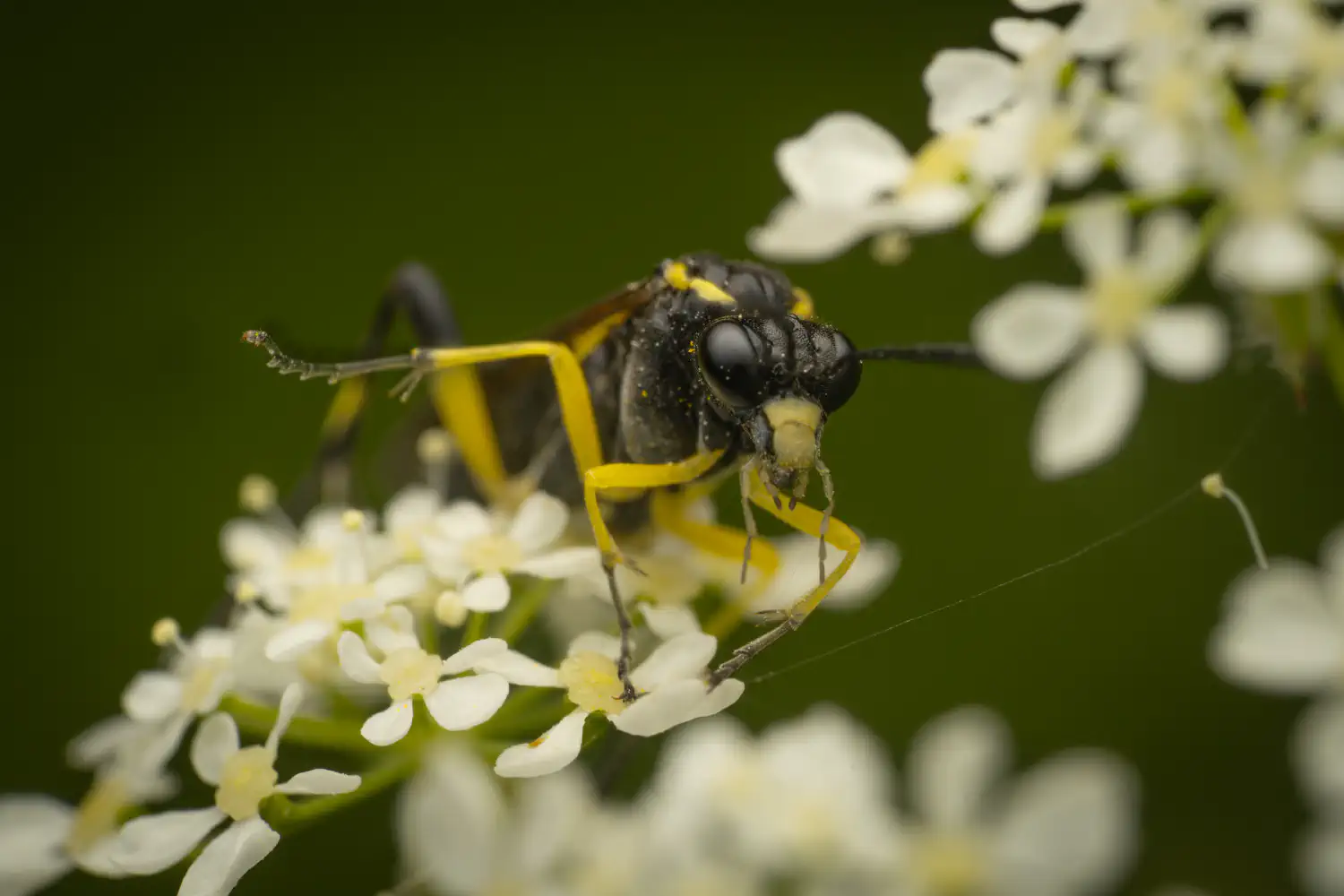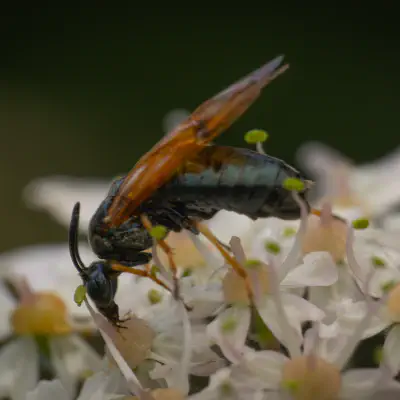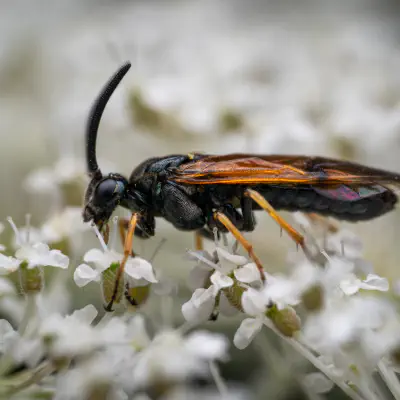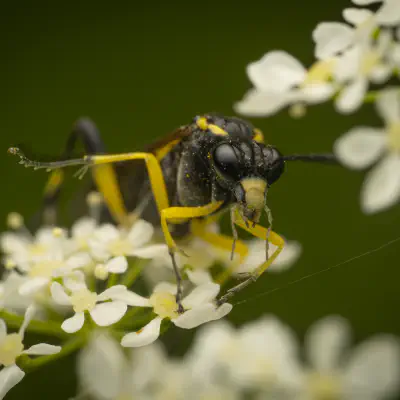Sawflies, Horntails, and Wood Wasps Lat. “Symphyta“
Sawflies are the insects of the suborder Symphyta within the order Hymenoptera alongside ants, bees and wasps. The common name comes from the saw-like appearance of the ovipositor, which the females use to cut into the plants where they lay their eggs. The name is associated especially with the Tenthredinoidea, by far the largest superfamily, with about 7,000 known species; in the entire suborder, there are 8,000 described species in more than 800 genera. The suborder…
Hierarchy
Etymology
The suborder name “Symphyta” derives from the Greek word symphyton, meaning ‘grown together’, referring to the group’s distinctive lack of a wasp waist between prostomium and peristomium. Its common name, “sawfly”, derives from the saw-like ovipositor that is used for egg-laying, in which a female makes a slit in either a stem or plant leaf to deposit the eggs. The first known use of this name was in 1773. Sawflies are also known as “wood-wasps”.
Phylogeny
In his original description of Hymenoptera in 1863, German zoologist Carl Gerstaecker divided them into three groups, Hymenoptera aculeata, Hymenoptera apocrita and Hymenoptera phytophaga. However, four years later in 1867, he described just two groups, H. apocrita syn. genuina and H. symphyta syn. phytophaga. Consequently, the name Symphyta is given to Gerstaecker as the zoological authority. In his description, Gerstaecker distinguished the two groups by the transfer of the first abdominal segment to the thorax in the Apocrita, compared to the Symphyta. Consequently, there are only eight dorsal half segments in the Apocrita, against nine in the Symphyta. The larvae are distinguished in a similar way. The Symphyta have therefore traditionally been considered, alongside the Apocrita, to form one of two suborders of Hymenoptera. Symphyta are the more primitive group, with comparatively complete venation, larvae that are largely phytophagous, and without a “wasp-waist”, a symplesiomorphic feature. Together, the Symphyta make up less than 10% of hymenopteran species. While the terms sawfly and Symphyta have been used synonymously, the Symphyta have also been divided into three groups, true sawflies (phyllophaga), woodwasps or xylophaga (Siricidae), and Orussidae. The three groupings have been distinguished by the true sawflies’ ventral serrated or saw-like ovipositor for sawing holes in vegetation to deposit eggs, while the woodwasp ovipositor penetrates wood and the Orussidae behave as external parasitoids of wood-boring beetles. The woodwasps themselves are a paraphyletic ancestral grade. Despite these limitations, the terms have utility and are common in the literature. While most hymenopteran superfamilies are monophyletic, as is Hymenoptera, the Symphyta has long been seen to be paraphyletic. Cladistic methods and molecular phylogenetics are improving the understanding of relationships between the superfamilies, resulting in revisions at the level of superfamily and family. The Symphyta are the most primitive (basal) taxa within the Hymenoptera (some going back 250 million years), and one of the taxa within the Symphyta gave rise to the monophyletic suborder Apocrita (wasps, bees, and ants). In cladistic analyses the Orussoidea are consistently the sister group to the Apocrita. The oldest unambiguous sawfly fossils date back to the Middle or Late Triassic. These fossils, from the family Xyelidae, are the oldest of all Hymenoptera. One fossil, Archexyela ipswichensis from Queensland is between 205.6 and 221.5 million years of age, making it among the oldest of all sawfly fossils. More Xyelid fossils have been discovered from the Middle Jurassic and the Cretaceous, but the family was less diverse then than during the Mesozoic and Tertiary. The subfamily Xyelinae were plentiful during these time periods, in which Tertiary faunas were dominated by the tribe Xyelini; these are indicative of a humid and warm climate. The cladogram is based on Schulmeister 2003.
Description
Many species of sawfly have retained their ancestral attributes throughout time, specifically their plant-eating habits, wing veins and the unmodified abdomen, where the first two segments appear like the succeeding segments. The absence of the narrow wasp waist distinguishes sawflies from other members of hymenoptera, although some are Batesian mimics with coloration similar to wasps and bees, and the ovipositor can be mistaken for a stinger. Most sawflies are stubby and soft-bodied, and fly weakly. Sawflies vary in length: Urocerus gigas, which can be mistaken as a wasp due to its black-and-yellow striped body, can grow up to 20 mm (3⁄4 in) in length, but among the largest sawflies ever discovered was Hoplitolyda duolunica from the Mesozoic, with a body length of 55 mm (2+1⁄4 in) and a wingspan of 92 mm (3+1⁄2 in). The smaller species only reach lengths of 2.5 mm (3⁄32 in). Heads of sawflies vary in size, shape and sturdiness, as well as the positions of the eyes and antennae. They are characterised in four head types: open head, maxapontal head, closed head and genapontal head. The open head is simplistic, whereas all the other heads are derived. The head is also hypognathous, meaning that the lower mouthparts are directed downwards. When in use, the mouthparts may be directed forwards, but this is only caused when the sawfly swings its entire head forward in a pendulum motion. Unlike most primitive insects, the sutures (rigid joints between two or more hard elements on an organism) and sclerites (hardened body parts) are obsolescent or absent. The clypeus (a sclerite that makes up an insects “face”) is not divided into a pre- and postclypeus, but rather separated from the front. The antennal sclerites are fused with the surrounding head capsule, but these are sometimes separated by a suture. The number of segments in the antennae vary from six in the Accorduleceridae to 30 or more in the Pamphiliidae. The compound eyes are large with a number of facets, and there are three ocelli between the dorsal portions of the compound eyes. The tentorium comprises the whole inner skeleton of the head. Three segments make up the thorax: the mesothorax, metathorax and prothorax, as well as the exoskeletal plates that connect with these segments. The legs have spurs on their fourth segments, the tibiae. Sawflies have two pairs of translucent wings. The fore and hind wings are locked together with hooks. Parallel development in sawfly wings is most frequent in the anal veins. In all sawflies, 2A and 3A tend to fuse with the first anal vein. This occurs in several families including Argidae, Diprionidae and Cimbicidae.
The larvae of sawflies are easily mistaken for lepidopteran larvae (caterpillars). However, several morphological differences can distinguish the two: while both larvae share three pairs of thoracic legs and an apical pair of abdominal prolegs, lepidopteran caterpillars have four pairs of prolegs on abdominal segments 3–6 while sawfly larvae have five pairs of prolegs located on abdominal segments 2–6; crochets are present on lepidopteran larvae, whereas on sawfly larvae they are not; the prolegs of both larvae gradually disappear by the time they burrow into the ground, therefore making it difficult to distinguish the two; and sawfly larvae only have a single pair of minute eyes, whereas lepidopteran larvae have four to six eyes on each side of the head. Sawfly larvae behave like lepidopteran larvae, walking about and eating foliage. Some groups have larvae that are eyeless and almost legless; these larvae make tunnels in plant tissues including wood. Many species of sawfly larvae are strikingly coloured, exhibiting colour combinations such as black and white while others are black and yellow. This is a warning colouration because some larvae can secrete irritating fluids from glands located on their undersides.
Distribution
Sawflies are widely distributed throughout the world. The largest family, the Tenthredinidae, with some 5,000 species, are found on all continents except Antarctica, though they are most abundant and diverse in the temperate regions of the northern hemisphere; they are absent from New Zealand and there are few of them in Australia. The next largest family, the Argidae, with some 800 species, is also worldwide, but is most common in the tropics, especially in Africa, where they feed on woody and herbaceous angiosperms. Of the other families, the Blasticotomidae and Megalodontidae are Palearctic; the Xyelidae, Pamphilidae, Diprionidae, Cimbicidae, and Cephidae are Holarctic, while the Siricidae are mainly Holarctic with some tropical species. The parasitic Orussidae are found worldwide, mostly in tropical and subtropical regions. The wood-boring Xiphydriidae are worldwide, but most species live in the subtropical parts of Asia.
Behaviour and ecology
Sawflies are mostly herbivores, feeding on plants that have a high concentration of chemical defences. These insects are either resistant to the chemical substances, or they avoid areas of the plant that have high concentrations of chemicals. The larvae primarily feed in groups; they are folivores, eating plants and fruits on native trees and shrubs, though some are parasitic. However, this is not always the case; Monterey pine sawfly (Itycorsia) larvae are solitary web-spinners that feed on Monterey pine trees inside a silken web. The adults feed on pollen and nectar.
Sawflies are eaten by a wide variety of predators. While many birds find the larvae distasteful, some such as the currawong (Strepera) and stonechats (Saxicola) eat both adults and larvae. The larvae are an important food source for the chicks of several birds, including partridges. Sawfly and moth larvae form one third of the diet of nestling corn buntings (Emberiza calandra), with sawfly larvae being eaten more frequently on cool days. Black grouse (Tetrao tetrix) chicks show a strong preference for sawfly larvae. Sawfly larvae formed 43% of the diet of chestnut-backed chickadees (Poecile rufescens). Small carnivorous mammals such as the masked shrew (Sorex cinereus), the northern short-tailed shrew (Blarina brevicauda) and the deer mouse (Peromyscus maniculatus) predate heavily on sawfly cocoons. Insects such as ants and certain species of predatory wasps (Vespula vulgaris) eat adult sawflies and the larvae, as do lizards and frogs. Pardalotes, honeyeaters and fantails (Rhipidura) occasionally consume laid eggs, and several species of beetle larvae prey on the pupae. The larvae have several anti-predator adaptations. While adults are unable to sting, the larvae of species such as the spitfire sawfly regurgitate a distasteful irritating liquid, which makes predators such as ants avoid the larvae. In some species, the larvae cluster together, reducing their chances of being killed, and in some cases form together with their heads pointing outwards or tap their abdomens up and down. Some adults bear black and yellow markings that mimic wasps.
Relationship with humans
Sawflies are major economic pests of forestry. Species in the Diprionidae, such as the pine sawflies, Diprion pini and Neodiprion sertifer, cause serious damage to pines in regions such as Scandinavia. D. pini larvae defoliated 500,000 hectares (1,200,000 acres) in the largest outbreak in Finland, between 1998 and 2001. Up to 75% of the trees may die after such outbreaks, as D. pini can remove all the leaves late in the growing season, leaving the trees too weak to survive the winter. Little damage to trees only occurs when the tree is large or when there is minimal presence of larvae. Eucalyptus trees can regenerate quickly from damage inflicted by the larvae; however, they can be substantially damaged from outbreaks, especially if they are young. The trees can be defoliated completely and may cause “dieback”, stunting or even death. Sawflies are serious pests in horticulture. Different species prefer different host plants, often being specific to a family or genus of hosts. For example, Iris sawfly larvae, emerging in summer, can quickly defoliate species of Iris including the yellow flag and other freshwater species. Similarly the rose sawflies, Arge pagana and A. ochropus, defoliate rose bushes. The giant woodwasp or horntail, Urocerus gigas, has a long ovipositor, which with its black and yellow colouration make it a good mimic of a hornet. Despite the alarming appearance, the insect cannot sting. The eggs are laid in the wood of conifers such as Douglas fir, pine, spruce, and larch. The larvae eat tunnels in the wood, causing economic damage. Alternative measures to control sawflies can be taken. Small-scale, mechanical methods include visually confirming larval presence on a plant and subsequently removing them, either by pruning damaged leaves or removing the larvae from the leaves they are on. Larvae typically try to remain hidden on the underside of foliage. Upon removing larvae and/or the affected leaves from plants, they may be dispatched by squishing, or, alternatively, the cut leaves with larvae still attached may be fed to birds; if larger animals do not prey upon them, other insects will. However, this is not practical or useful for some, thus the larvae can be quickly dispatched by simply dropping foliage into a vessel of plain or saltwater, diluted hydrogen peroxide or isopropyl alcohol, insecticidal soap, or other garden chemical. In large-scale, industrial settings, where beneficial insect predators can also be used to eliminate larvae, as well as parasites, which have both been previously used in control programs. Small trees can be sprayed with a number of chemicals, including maldison, dimethoate, carbaryl, imidacloprid, etc., if removing larvae from trees is not effective enough.
Further reading
Blank, S.M.; Schmidt, S.; Taeger, A. (2006). Recent Sawfly Research Synthesis and Prospects. Keltern, Germany: Goecke und Evers. ISBN 978-3-937783-19-2. Schedl, Wolfgang. (2016). Hymenoptera, Unterordnung Symphyta: Pflanzenwespen. Walter de Gruyter. ISBN 978-3-11-085790-0. Smith, D.R. (1969). Nearctic Sawflies I. Blennocampinae: Adults and Larvae (Hymenoptera: Tenthredinidae) (Technical Bulletin 1397). Washington, D.C.: US Department of Agriculture. Smith, D.R. (1969). Nearctic Sawflies II. Selandriinae: Adults and Larvae (Hymenoptera: Tenthredinidae) (Technical Bulletin 1398). Washington, D.C.: US Department of Agriculture. Smith, D.R. (1971). Nearctic Sawflies III. Heterarthrinae: Adults and Larvae (Hymenoptera: Tenthredinidae) (Technical Bulletin 1420). Washington, D.C.: US Department of Agriculture. Archived from the original on 21 October 2020. Retrieved 29 December 2018. Smith, D.R. (1979). Nearctic Sawflies IV. Allantinae: Adults and Larvae (Hymenoptera: Tenthredinidae) (Technical Bulletin 1595). Washington, D.C.: US Department of Agriculture. Wagner, M.R.; Raffa, K.F. (1993). Sawfly Life History Adaptations to Woody Plants. San Diego, California: Academic Press. ISBN 978-0-12-730030-6.
External links
Data related to Symphyta at Wikispecies Media related to Symphyta at Wikimedia Commons
Ancestry Graph
Further Information
„Sawflies, Horntails, and Wood Wasps“ on wikipedia.org
„Sawflies, Horntails, and Wood Wasps“ on iNaturalist.org
Copyright

This article uses material from the Wikipedia article Symphyta the free encyclopedia Wikipedia which is released under Creative Commons Attribution-ShareAlike 4.0 International License). On Wikipedia a list of authors is available.

Little beings in print
Order our calendars and books today!
Compiled with love. Printed sustainably. Experience our little beings even more vividly in print. All our publications are available for a small donation.




